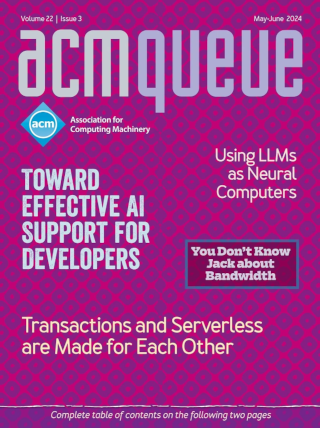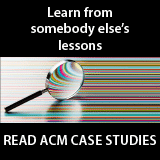Kode Vicious Gets Dirty:
A koder with attitude, KV answers your questions. Miss Manners he ain’t.
Dear Kode Vicious, I am a new Webmaster of a (rather new) Web site in my company’s intranet. Recently I noticed that although I have implemented some user authentication (a start *.asp page linked to an SQL server, having usernames and passwords), some of the users found out that it is also possible to enter a rather longer URL to a specific page within that Web site (instead of entering the homepage), and they go directly to that page without being authenticated (and without their login being recorded in the SQL database).
Building Secure Web Applications:
Believe it or not, it’s not a lost cause.
In these days of phishing and near-daily announcements of identity theft via large-scale data losses, it seems almost ridiculous to talk about securing the Web. At this point most people seem ready to throw up their hands at the idea or to lock down one small component that they can control in order to keep the perceived chaos at bay.
Phishing Forbidden:
Current anti-phishing technologies prevent users from taking the bait.
Phishing is a significant risk facing Internet users today. Through e-mails or instant messages, users are led to counterfeit Web sites designed to trick them into divulging usernames, passwords, account numbers, and personal information. It is up to the user to ensure the authenticity of the Web site. Browsers provide some tools, but these are limited by at least three issues.
Usablity Testing for the Web:
Today’s sophisticated Web applications make tracking and listening to users more important than ever.
Today’s Internet user has more choices than ever before, with many competing sites offering similar services. This proliferation of options provides ample opportunity for users to explore different sites and find out which one best suits their needs for any particular service. Users are further served by the latest generation of Web technologies and services, commonly dubbed Web 2.0, which enables a better, more personalized user experience and encourages user-generated content.
Voyage in the Agile Memeplex:
In the world of agile development, context is key.
Agile processes are not a technology, not a science, not a product. They constitute a space somewhat hard to define. Agile methods, or more precisely agile software development methods or processes, are a family of approaches and practices for developing software systems. Any attempt to define them runs into egos and marketing posturing. For our purposes here, we can define this space in two ways: By enumeration. Pointing to recognizable members of the set: XP, scrum, lean development, DSDM, Crystal, FDD, Agile RUP or OpenUP, etc.
From Here to There, the SOA Way:
SOA is no more a silver bullet than the approaches that preceded it.
Back in ancient times, say, around the mid ’80s when I was a grad student, distributed systems research was in its heyday. Systems like Trellis/Owl and Eden/Emerald were exploring issues in object-oriented language design, persistence, and distributed computing. One of the big themes to come out of that time period was location transparency—the idea that the way that you access an object should be independent of where it is located. That is, it shouldn’t matter whether an object is in the same process, on the same machine in a different process, or on another machine altogether.
Things I Learned in School:
As we continue to develop the new UI for our product, we’ll definitely be using FSMs wherever possible.
How many of us have not had the experience of sitting in a classroom wondering idly: "Is this really going to matter out in the real world?" It’s curious, and in no small amount humbling, to realize how many of those nuggets of knowledge really do matter. One cropped up recently for me: the Finite State Machine.
XML Fever:
Don’t let delusions about XML develop into a virulent strain of XML fever.
XML (Extensible Markup Language), which just celebrated its 10th birthday, is one of the big success stories of the Web. Apart from basic Web technologies (URIs, HTTP, and HTML) and the advanced scripting driving the Web 2.0 wave, XML is by far the most successful and ubiquitous Web technology. With great power, however, comes great responsibility, so while XML’s success is well earned as the first truly universal standard for structured data, it must now deal with numerous problems that have grown up around it.
The Obama Campaign:
The Obama campaign has been praised for its innovative use of technology. What was the key to its success?
On January 3, 2008, I sat in the boiler room waiting for the caucus to commence. At 7 p.m. the doors had been open for about an hour: months of preparation were coming to fruition. The phone calls had been made, volunteers had been canvassing, and now the moment had come. Could Barack Obama win the Iowa caucus? Doors closed and the first text message came from a precinct: it looked like a large attendance. Then came the second, the third, the fourth. Each was typed into our model, and a projection was starting to form. The fifth, the sixth, and now the seventh.
Case Study: Making the Move to AJAX:
What a software-as-a-service provider learned from using an AJAX framework for RIA development
Small start-up companies often face a bewildering array of technical choices: how to deliver their application, what language to use, whether to employ existing components (either commercial or open source) or roll their own... and the list goes on. What’s more, the decisions surrounding these choices typically need to be made quickly. This case study offers a realistic representation of the sorts of challenges a young start-up company faces when working to deploy a product on the Web. As with many startups, this is also a story that does not have a happy ending.
Debugging AJAX in Production:
Lacking proper browser support, what steps can we take to debug production AJAX code?
The JavaScript language has a curious history. What began as a simple tool to let Web developers add dynamic elements to otherwise static Web pages has since evolved into the core of a complex platform for delivering Web-based applications. In the early days, the language’s ability to handle failure silently was seen as a benefit. If an image rollover failed, it was better to preserve a seamless Web experience than to present the user with unsightly error dialogs.
Reveling in Constraints:
The Google Web Toolkit is an end-run around Web development obstacles.
The Web’s trajectory toward interactivity, which began with humble snippets of JavaScript used to validate HTML forms, has really started to accelerate of late. A new breed of Web applications is starting to emerge that sports increasingly interactive user interfaces based on direct manipulations of the browser DOM (document object model) via ever-increasing amounts of JavaScript. Google Wave, publicly demonstrated for the first time in May 2009 at the Google I/O Developer Conference in San Francisco, exemplifies this new style of Web application.
Your Mouse is a Database:
Web and mobile applications are increasingly composed of asynchronous and realtime streaming services and push notifications.
Among the hottest buzzwords in the IT industry these days is "big data," but the "big" is something of a misnomer: big data is not just about volume, but also about velocity and variety. The volume of data ranges from a small number of items stored in the closed world of a conventional RDMS (relational database management system) to a large number of items spread out over a large cluster of machines or across the entire World Wide Web.
Idempotence Is Not a Medical Condition:
An essential property for reliable systems
The definition of distributed computing can be confusing. Sometimes, it refers to a tightly coupled cluster of computers working together to look like one larger computer. More often, however, it refers to a bunch of loosely related applications chattering together without a lot of system-level support. This lack of support in distributed computing environments makes it difficult to write applications that work together. Messages sent between systems do not have crisp guarantees for delivery. They can get lost, and so, after a timeout, they are retried. The application on the other side of the communication may see multiple messages arrive where one was intended.
Multitier Programming in Hop:
A first step toward programming 21st-century applications
The Web is becoming the richest platform on which to create computer applications. Its power comes from three elements: (1) modern Web browsers enable highly sophisticated GUIs with 3D, multimedia, fancy typesetting, etc.; (2) calling existing services through Web APIs makes it possible to develop sophisticated applications from independently available components; and (3) open data availability allows applications to access a wide set of information that was unreachable or that simply did not exist before. The combination of these three elements has already given birth to revolutionary applications such as Google Maps, radio podcasts, and social networks.
Making the Mobile Web Faster:
Mobile performance issues? Fix the back end, not just the client.
Mobile clients have been on the rise and will only continue to grow. This means that if you are serving clients over the Internet, you cannot ignore the customer experience on a mobile device. There are many informative articles on mobile performance, and just as many on general API design, but you’ll find few discussing the design considerations needed to optimize the back-end systems for mobile clients. Whether you have an app, mobile Web site, or both, it is likely that these clients are consuming APIs from your back-end systems.
The Story of the Teapot in DHTML:
It’s easy to do amazing things, such as rendering the classic teapot in HTML and CSS.
Before there was SVG (Scalable Vector Graphics), WebGL (Web Graphics Library), Canvas, or much of anything for graphics in the browser, it was possible to do quite a lot more than was initially obvious. To demonstrate, we created a JavaScript program that renders polygonal 3D graphics using nothing more than HTML and CSS. Our proof-of-concept is fast enough to support physics-based small-game content, but we started with the iconic 3D "Utah teapot" because it tells the whole story in one picture. It’s feasible to render this classic object using just regular DIV elements, CSS styles, and a little bit of JavaScript code.
The Evolution of Web Development for Mobile Devices:
Building Web sites that perform well on mobile devices remains a challenge.
The biggest change in Web development over the past few years has been the remarkable rise of mobile computing. Mobile phones used to be extremely limited devices that were best used for making phone calls and sending short text messages. Today’s mobile phones are more powerful than the computers that took Apollo 11 to the moon with the ability to send data to and from nearly anywhere.
Best Practices on the Move: Building Web Apps for Mobile Devices:
Which practices should be modified or avoided altogether by developers for the mobile Web?
If it wasn’t your priority last year or the year before, it’s sure to be your priority now: bring your Web site or service to mobile devices in 2013 or suffer the consequences. Early adopters have been talking about mobile taking over since 1999 - anticipating the trend by only a decade or so. Today, mobile Web traffic is dramatically on the rise, and creating a slick mobile experience is at the top of everyone’s mind. Total mobile data traffic is expected to exceed 10 exabytes per month by 2017.
Rules for Mobile Performance Optimization:
An overview of techniques to speed page loading
Performance has always been crucial to the success of Web sites. A growing body of research has proven that even small improvements in page-load times lead to more sales, more ad revenue, more stickiness, and more customer satisfaction for enterprises ranging from small e-commerce shops to megachains such as Walmart.
20 Obstacles to Scalability:
Watch out for these pitfalls that can prevent Web application scaling.
Web applications can grow in fits and starts. Customer numbers can increase rapidly, and application usage patterns can vary seasonally. This unpredictability necessitates an application that is scalable. What is the best way of achieving scalability?
Making the Web Faster with HTTP 2.0:
HTTP continues to evolve
HTTP (Hypertext Transfer Protocol) is one of the most widely used application protocols on the Internet. Since its publication, RFC 2616 (HTTP 1.1) has served as a foundation for the unprecedented growth of the Internet: billions of devices of all shapes and sizes, from desktop computers to the tiny Web devices in our pockets, speak HTTP every day to deliver news, video, and millions of other Web applications we have all come to depend on in our everyday lives.
JavaScript and the Netflix User Interface:
Conditional dependency resolution
In the two decades since its introduction, JavaScript has become the de facto official language of the Web. JavaScript trumps every other language when it comes to the number of runtime environments in the wild. Nearly every consumer hardware device on the market today supports the language in some way. While this is done most commonly through the integration of a Web browser application, many devices now also support Web views natively as part of the operating system UI (user interface).
Dismantling the Barriers to Entry:
We have to choose to build a web that is accessible to everyone.
A war is being waged in the world of web development. On one side is a vanguard of toolmakers and tool users, who thrive on the destruction of bad old ideas ("old," in this milieu, meaning anything that debuted on Hacker News more than a month ago) and raucous debates about transpilers and suchlike.
Beyond Page Objects: Testing Web Applications with State Objects:
Use states to drive your tests
End-to-end testing of Web applications typically involves tricky interactions with Web pages by means of a framework such as Selenium WebDriver. The recommended method for hiding such Web-page intricacies is to use page objects, but there are questions to answer first: Which page objects should you create when testing Web applications? What actions should you include in a page object? Which test scenarios should you specify, given your page objects?
Componentizing the Web:
We may be on the cusp of a new revolution in web development.
There is no task in software engineering today quite as herculean as web development. A typical specification for a web application might read: The app must work across a wide variety of browsers. It must run animations at 60 fps. It must be immediately responsive to touch. It must conform to a specific set of design principles and specs. It must work on just about every screen size imaginable, from TVs and 30-inch monitors to mobile phones and watch faces. It must be well-engineered and maintainable in the long term.
React: Facebook’s Functional Turn on Writing JavaScript:
A discussion with Pete Hunt, Paul O’Shannessy, Dave Smith and Terry Coatta
One of the long-standing ironies of user-friendly JavaScript front ends is that building them typically involved trudging through the DOM (Document Object Model), hardly known for its friendliness to developers. But now developers have a way to avoid directly interacting with the DOM, thanks to Facebook’s decision to open-source its React library for the construction of user interface components.
Research for Practice: Web Security and Mobile Web Computing:
Expert-curated Guides to the Best of CS Research
Our third installment of Research for Practice brings readings spanning programming languages, compilers, privacy, and the mobile web.
Why SRE Documents Matter:
How documentation enables SRE teams to manage new and existing services
SRE (site reliability engineering) is a job function, a mindset, and a set of engineering approaches for making web products and services run reliably. SREs operate at the intersection of software development and systems engineering to solve operational problems and engineer solutions to design, build, and run large-scale distributed systems scalably, reliably, and efficiently. A mature SRE team likely has well-defined bodies of documentation associated with many SRE functions.






